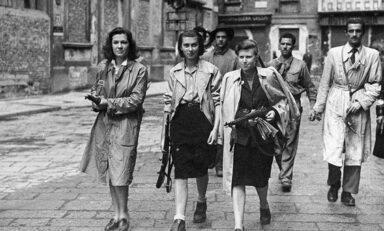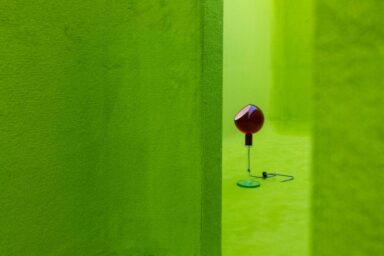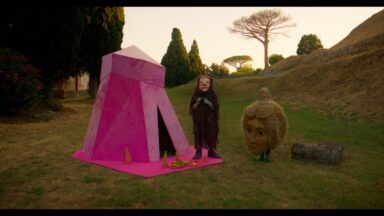Collectible DRY spoke with the five emerging artists behind The Reality in Whytch You Create, STUDIO WEST’s inaugural group show on display in Notting Hill until February 17
Words by: Gilda Bruno
Launched at the newly opened contemporary art gallery STUDIO WEST on January 14, The Reality in Whytch You Create is a group show bringing together some of the most exciting personalities on London’s emerging art scene. Featuring paintings from Alfie Rouy, Anna Woodward, Lydia Makin and Sholto Blissett accompanied by sound and video pieces by multidisciplinary artist Salomé Wu, the exhibition turns the spotlight onto the concept of ‘reality’ — here conceived in an expanded sense — “drawing on dreams, subconscious experience, and myths.”
Named after one of the artworks currently showing at the gallery, namely Rouy’s The Reality in Whytch You Create is Swyphtly Healed by Devotion to Good (2020), the event invites creatives and the public alike to reconsider their take on reality by immersing viewers in otherworldly fantasies, surreal landscapes and hypothetical post-human scenarios. In The Reality in Whytch You Create, “each artist imagined a constructed world in their own particular way,” says STUDIO WEST’s owner and curator Caroline Boseley. As I take a glance at the hypnotising canvases on display, it seems no coincidence to me that the idea for this first show came straight from one of the participating artists:

“I met Lydia Makin at the Slade graduate show in mid-2021 and was transfixed by her stunning, large-scale canvases,” she explains. “One of the works displayed was Grace (2021) and it was this beautiful work with its ethereal central figure, that inspired me to curate this particular show. I had Sholto Blissett’s work in mind too; in Garden of Hubris XXV (2021) his precise lines, and immaculate brushwork portray a constructed land, which looks too perfect to be true. From there the other artists were selected, all of whom explore imaginary worlds, altered realities and dream-like spaces; the works blend so well together, whilst being visually very different, and share common influences such as classicism, architecture and escapism.”
Talking about how the pandemic brought artists and art professionals to reassess their priorities — “people spent a lot more time at home, enhancing their living spaces. Murals and public art expanded, with people yearning for visual treats, whilst exploring their neighbourhoods.” — Boseley also stressed the need to break free from unwelcoming ‘white cube’ galleries and create “a platform for emerging artists to show their work in an inviting and hospitable exhibition space and a creative centre in a broader sense.” Below, the five protagonists of The Reality in Whytch You Create discuss the visions at the core of their artworks, their inspirations and process, letting us into their ‘boundless’ world.
Alfie Rouy

Courtesy of Alfie Rouy
“My previous works have been inspired and influenced by Hermeticism and the ideas prominent within it. However, in saying this I don’t actively try to depict these themes in my work — more they come to me subconsciously and are then translated in such a way that they aren’t direct references. I tend to find inspiration internally, therefore my work isn’t necessarily a nuanced take on past historical or philosophical movements but something that comes from my subconscious.”
“When I created The Reality in Whytch You Create is Swyphtly Healed by Devotion to Good (2020), I was inspired by a dream I had where I saw a scythe coming out from the top of a foot that transforms itself, just like in the painting. Three months later, while reading a book on alchemy, I came across two emblems of almost this exact thing (a scythe cutting through the leg of Hermes): the synchronicity between my dream and this image solidified the idea of painting this piece.”
Lydia Makin

Lydia Makin photographed by Elena Makin
“Nature permeates my work through a variety of channels: the sensual, the structural, the psychological and the symbolic. I seek to absorb, explore, recombine and transform these in unusual ways to create a heightened moment — an epiphany — that is unexpected, yet strangely familiar and intimate. My creative process does not follow a linear logic and avoids any form of literalism; my art cannot be said to be ‘about’ any preordained theme or concept. Still, I strongly believe that the existential peril humanity faces comes from a loss of intimacy with nature, from a progressive deadening of the human senses and resultant loss of meaning. With my craft, I aim to restore that intimacy on a small scale, to revive the senses and rekindle that sense of meaning.”
“Figurative elements in my work are evocative yet open-ended, strongly suggestive but not without a certain ambiguity. Is it a saint, a ghost, a memory, a thought-form, all of these, or something else entirely? Every viewer adds something of themselves in what they see. My role is not to direct the viewer toward a particular viewpoint, ideology, or philosophical outlook. Instead, I want my paintings to be a gateway or portal, one that beckons the viewer into their own senses, dreamworld and inner symbolic life; to a place where they may discover their own meanings, desires, longings, joys and sorrows. It is my hope that they will emerge from this encounter with enlivened passions, clarity, renewed and empowered feelings.”
Sholto Blisset

Sholto Blissett photographed by Brynley Odu Davies
“I have always enjoyed painting as a means of expression above any other artistic medium, and landscape painting especially. This combination of method and genre allows me to imagine and create new scenes, new ways of thinking. As a child, this was born out of innocent whimsy; as I got older, I was introduced to Romanticism and subsequent critiques of this movement: specifically, Romanticism’s effect on the land and our – human’s – relationship to the land.”
“This connection has been accentuated over the last two years: lockdowns and social distancing requirements have attuned us to our spatial awareness in relation to other people, the ‘outdoors’ and wider global geographies. Interestingly, the pandemic has shifted many peoples’ attitudes about vast, open, isolated spaces from (traditional) negative feelings, to positive: it is only in these large spaces that many feel ‘safe’, away from human and airborne contagion. It is this reinvigorated sense of awareness about self-in-space that I hope my audience connects to when viewing my work.”
“Art is exciting, it can make you think or trigger memories or evoke emotions.” — Caroline Boseley
“Whilst influences can’t be avoided in any art, I’d like to think – at least, I feel – that I don’t consciously work in imitation of artists. I paint for myself and what excites me. However, as an artist dealing with the history of European and American depictions of ‘Nature’, I have been attentive to the works of similar artists, from the 18th century to today: Claude, Bierstadt, members of the Hudson River School, and Kehinde Wiley as well as examining the artistic techniques of Turner.”
“As the title suggests, or at least, how I interpret it, The Reality in Whytch You Create revolves around our experience in the world: subjectivity, the unconscious, and constructed narratives. The alternative spelling of ‘whytch’ seems to pun on the alternative realities we can create. Indeed, the attention given to this word also makes me think of “witches”: icons of creation, deception, magic. To me, this show is all about reflecting on our lived fictions. This is what my work highlights: specifically, the categories of ‘man’ and ‘Nature’ and the very fabrication of that distinction. This has been a key element to my Garden of Hubris series, Garden of Hubris XXV being the painting that I feel best encapsulates this.”
Salomé Wu

Salome Wu photographed by Liza Molnar
“I feel incredibly grateful to exhibit my installation in this group show since I rarely get opportunities to show my video pieces. I like how all of the artists’ creative universes interact in the same space. For me, it is fundamental to stress that my ideas are not limited to one particular form of medium or expression; performance and video are crucial to my practice, yet I also consider my painting pieces to be performative and not only exist on a two-dimensional surface. Melancholia, joy and brushmarks permeate my artworks. I see melancholia and joy as inseparable ideas: I want viewers to lose and find themselves in my work, to remind people what’s important to them, what they cherish. I believe my pieces convey emotions and experiences that can be universally understood.”
“Since the outbreak of Covid-19, the passing of time has become a much more abstract idea. Time feels different when no activities or events mark its pace. When our reality narrowed down into a box of air, being in front of my digital devices receiving news about the world plunged into chaos reminded me of the fragility in our human experiences. It has been surreal: I spent a significant amount of time in front of my art, reflecting and grieving. Still, it gave me the freedom to see our day to day reality differently.”
“Wind Stood Still, Dancing Silently (2021), my video piece, was an interesting response to the world around me at the time. There weren’t too many thoughts on the filming location, I was naturally drawn to those sites. While looking at the work of female artists such as Francesca Woodman and Ana Mendieta, I felt the urge to try something different. I remember reading something Mendieta had said in an interview on the body’s desire to unite with mother nature: as water is a crucial source for life to emerge, perhaps subconsciously, I instantly found much comfort and inspiration in that idea. That’s what motivated me to create this piece.”
Anna Woodward

Anna Woodward photographed by Brynley Odu Davies
“Ever since childhood, I have always been drawn to nature and plants. I grew up in the countryside and, as a child, I would always be outside. However, my connection to nature is something I am only now understanding to be such an integral part of my practice. In fact, the majority of my source materials are botanical illustrations; a preference that allows me to manipulate the original motifs into my own weird beings.”
“The fact that we do not know how the world is going to look in 100 years’ time, especially due to climate change, is something I am particularly interested in. I am fascinated by the thought of how plants will adapt to such a shift, which is also why none of my artworks is a study of ‘real’ vegetation. I look at plants as beings that will overlive us once everything else has been destroyed. Within my works, my landscape-style paintings are more and more often taking on the shapes of utopian scenes: something I am looking forward to both expanding and hearing people’s thoughts on.”
The Reality in Whytch You Create is open at STUDIO WEST until February 17



